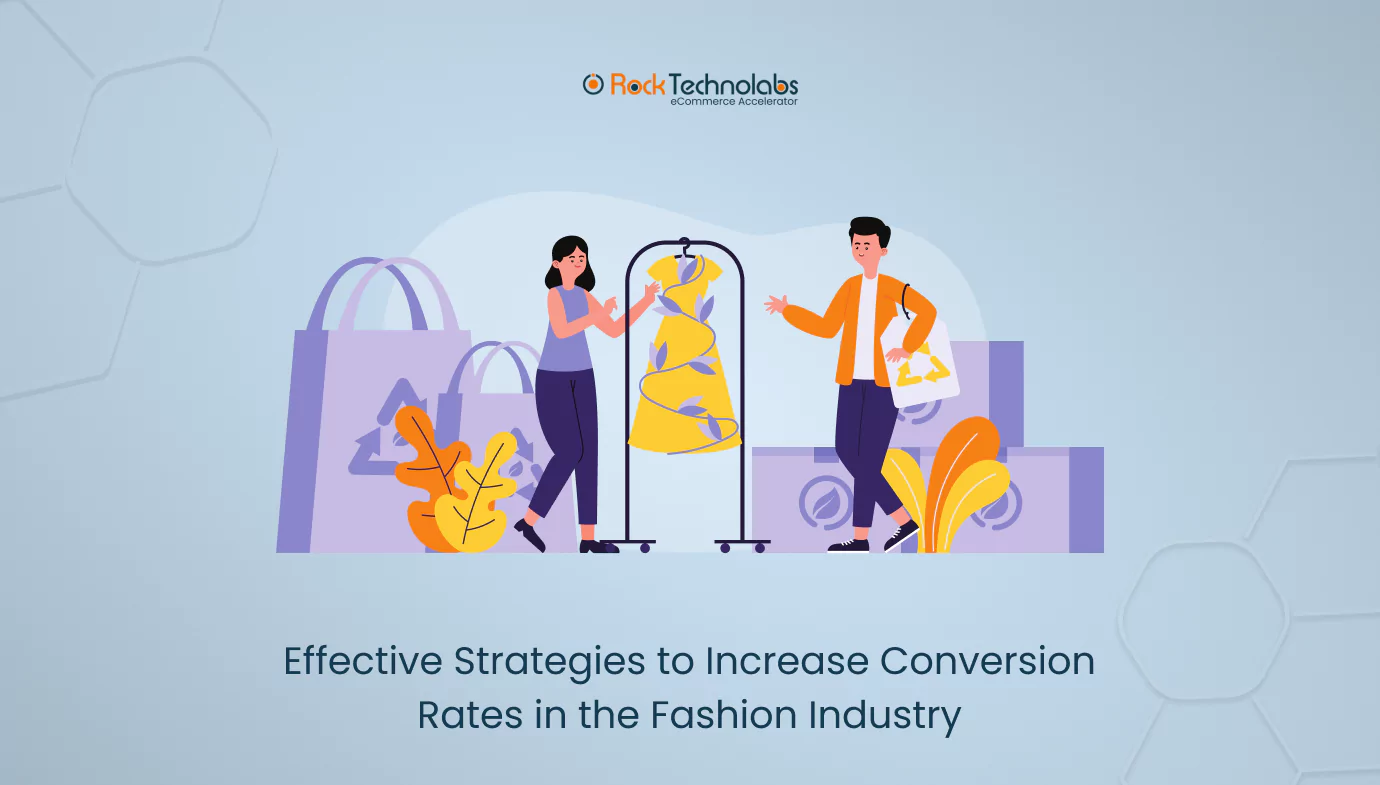Effective Strategies to Increase Conversion Rates in the Fashion Industry

Fashion is considered one of the biggest industries in the world, that plays a significant role in driving the economy. Revenue in the Fashion Market is projected to reach US$770.90bn in 2024, and is also predicted to indicate an annual growth rate (CAGR 2024-2029) of 8.94%, resulting in a projected market volume of US$1,183.00bn by 2029, which clearly stated that fashion industry is growing day by day; thus there will be more competition.
Moreover, this data is also contributed by the fashion e-commerce stores created on various platforms like Shopify and Magento 2 Hyva theme in Magento that are now more visited by the buyers as compared to offline stores, ultimately disrupting traditional retail models and giving rise to a new wave of fashion brands that sell directly to consumers through their own online platforms.
Now, the fashion industry offers a lot of opportunities and challenges. With numerous competitors competing for user attention across various devices, channels, languages, and borders, it has become increasingly challenging for original brands to stand out and build a loyal list of consumers because a slight mistake or negligence, or even whole efforts are proving less as compared to what demanded by the buyers.
Regardless of age, gender, or occupation, everyone needs clothing and wants to look their best. So, if you’re considering starting a fashion-based business or already have a retail e-commerce store, now is the perfect time to showcase to your customers what you are bringing to the table and how you are different than others.
You can do this by leveraging various effective strategies specifically created to serve fashion e-commerce stores like yours to beat the fierce competition and influence your buyers enough so they fall in love with your brand.
Now, where should you start? For that, go through the top growth strategy below to increase conversion rates and boost your fashion brand.
Utilize User-Generated Content: Feature Shoppable UGC Posts
User-generated content (UGC), especially from social media sites like Instagram & Facebook, can greatly improve your fashion e-commerce store’s conversion rates. Authentic social media posts from customers build social trust and seamlessly connect inspiration with the point of sale. By embedding shoppable UGC posts on your website, you can reduce confusion and cart abandonment, leading to higher conversions.
Maximize Social Media Engagement
This is basically a form of video reviews or other social media tactics in which you have to encourage your customers to share their experiences with your products on platforms like Instagram, Facebook, and Pinterest. Plus, side by side, you have to completely handle the social media accounts and focus on actively running different short-term and long-term campaigns and contests that incentivize user-generated content and boost engagement.
This type of social media marketing activity not only helps boost your brand image but also gives powerful insights into your buyers’ minds of what they desire and think in general, helping you assess and demonstrate the impact of your products on your audience.
Use AI-Driven Solutions: Improve Customer Experience and Increase Sales
Artificial intelligence (AI) is a powerful tool for fashion e-commerce stores aiming to optimize conversion rates. Implementing AI-driven solutions like advanced site search and shopping assistant chatbots can enhance the customer experience and drive more sales.
AI-Powered Site Search
Integrating AI-powered site search transforms the user experience. For instance, if a customer searches for “stylish summer dresses,” AI search understands their intent and delivers relevant results, showcasing a range of fashionable dresses for the season.
To increase conversions, AI search ranks results based on performance metrics such as engagement, revenue generation, and customer ratings. This feature not only boosts sales but also enhances customer satisfaction.
Design a Beautiful and User-Friendly Ecommerce Website
While technical details like speed and fraud prevention are crucial when building an e-commerce website, customers also expect an aesthetically pleasing shopping experience from fashion brands that can be offered to customers with a Magento 2 hyva theme. They want to see appealing imagery and a smooth browsing experience. Therefore, prioritize the customer experience in your design of the Magento store.
For instance, incorporating multimedia content in blog posts can enhance your content and boost customer engagement by 21%. Additionally, creating a personalized shopping experience by segmenting customers based on device type, traffic source, shopping cart item count, and more can lead to higher conversion rates than generic landing pages.
Offer Free Shipping and Returns
Fashion brands often face additional challenges with sizing issues. Customers are more likely to complete a purchase if they know they can return the product easily. A good return policy instills confidence in your service and product.
By offering free shipping and returns, you clearly indicate to your customers that you are willing to bear some cost to satisfy what they want. Plus, this kind of strategy leads to repeated purchases from the same brand, thus also help in reducing the cart abandonment rate of your e-commerce store due to additional fees, shipping costs, and the hassle of returning items.
Navigation and Categorization
Always design your store by keeping the end user in mind; think about what kind of website you would like to purchase from when you visit a fashion e-commerce store. The fewer hurdles, frustration, and confusion your users face, the more time they spend on your store and the more conversion your store gets.
However, these practices involve effective navigation with intuitive menu structures, prominent search functionality, and well-organized product categories.
For this, let’s take an example: a fashion e-commerce website selling clothes for women; now, the category includes western wear, ethnic wear, top brands, and so on.
Within each category, subcategories like “Dresses,” “Tops,” “Bottoms,” “kurta sets,” and “Outerwear” enhance the browsing experience. Plus, filters for size, color, and price range further help customers quickly narrow down their choices, boosting the conversion rate.
A/B Testing
If you have a Magento store with the Magento 2 hyva theme, chances are you are aware of the term A/B testing or split testing. A/B testing is basically used to compare different versions of webpages, marketing campaigns, and other website elements like product listings, which allow you to make data-driven decisions for various actions or features of your store.
You can implement A/B testing in various areas of your e-commerce store, like call to action (by testing different elements such as wording, color, placement, size, design, or emojis), for promotional popups (paying attention to the design, messaging, and incentives given to the customer), product images (with different sizes, graphics, and angles), and product title and copy.
Create a Frictionless Checkout Process
Before adding new personalization tools or features, focus on optimizing your checkout process with a mobile-first approach. Americans spend 88% of their mobile time on apps, where conversions are 50% lower than on desktops.
Optimizing your checkout process for mobile shoppers ensures a better experience for everyone. Offer a guest checkout option to avoid forcing shoppers to create an account to complete a purchase.
Many shoppers add items to their cart from a mobile version of an e-commerce store but log onto a desktop to complete their purchase. A third of all retail transactions occur across at least two devices. Use multi-device cross-platform features to ensure any products remain in the cart across multiple devices.
Let Customers Save and Compare Products to Boost Conversion Rates
Window shopping has simply evolved into the online space. Some customers may want to save items for later, whether it’s for payday, splurging, or sharing gift ideas. Implementing a wish list feature can be beneficial for several reasons:
– It encourages customers to return for out-of-stock items.
– It helps you understand each shopper’s interests and habits.
– It’s convenient for mobile shoppers who prefer not to add items to their cart or checkout on a smartphone.
Just like your shopping cart, ensure that your fashion site’s wish list can transfer items across multiple devices to provide a seamless digital experience.
Comparison tools are also essential for increasing conversion rates. In a physical store, shoppers often compare similar items before making a decision. Online comparison tools can replicate this experience, allowing customers to analyze and choose between products more easily.
Ask Shoppers to Personalize Their Own Experience
Dynamic content is a powerful way to hyper-personalize every shopper’s digital journey. Start by using cookies or an IP address to tailor shipping rates or product recommendations based on a visitor’s location and preferences in your Magento 2 hyva theme e-commerce store.
You can also directly involve your shoppers in personalizing their experience. Your fashion website could adopt a similar approach, gathering shopper input before presenting the full site.
An interactive survey spread across several screens can make this process engaging. Despite taking a few minutes to complete, answering these questions can be enjoyable for shoppers, and they will appreciate receiving personalized recommendations afterward.
Additionally, personalize based on activity from other channels like email or social media, along with previous purchases. By combining data from multiple sources, you can learn about each customer’s style and shopping habits, offering tailored recommendations on your site.
Geo-Targeting
If your business includes local boutiques or physical stores, consider implementing geo-targeted pop-ups for visitors in specific areas. Here are some strategies you can use:
– Cart Abandonment Alerts: Notify visitors of nearby stores where they can find items left in their cart, which is particularly useful if shipping times are a concern.
– Buy Online, Pick Up In-Store: Promote faster fulfillment options by letting customers know they can pick up their online orders at a nearby location.
– Store Inventory: Help customers find out-of-stock colors or sizes in nearby stores.
– Shipping Delays: Clearly communicate any shipping delays to customers in specific areas. Use banners to inform shoppers of delays, which is especially important for time-sensitive purchases like events or holiday outfits. This transparency helps build trust with your customers.





